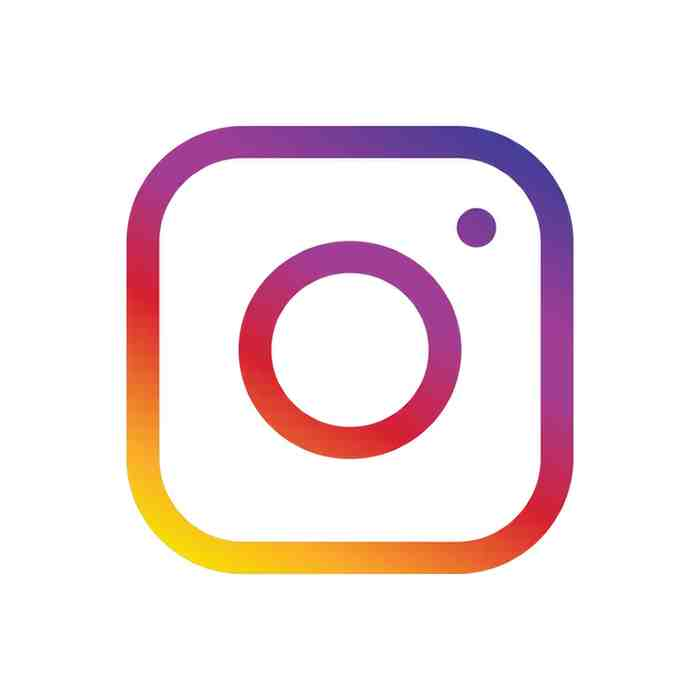Posted by: Northwest Eye in General on November 20, 2025
Introduction
Understanding the nuances of corneal abrasions is crucial for anyone who has ever felt the sharp pain and discomfort of an eye scratch. We understand that healing times can vary, typically ranging from just a day to a week. While recovery can be swift, it often comes with uncertainty and concern about potential complications.
This article delves into essential insights regarding corneal abrasion healing time and care. We’re here to offer valuable tips and expert guidance to help you navigate this process smoothly. It’s common to feel anxious about what happens when healing doesn’t go as planned. How can you effectively manage the complexities of eye injury care?
Let’s explore this together, ensuring you feel supported every step of the way.
Northwest Eye: Expert Care for Corneal Abrasions
At Northwest Eye, we truly understand how concerning corneal abrasions can be. Our dedicated team of skilled ophthalmic surgeons specializes in advanced treatment techniques, ensuring that you receive the best care possible. We create personalized care plans tailored to your specific needs, which helps promote optimal healing results.
We believe that patient education is vital. By helping you comprehend your condition and the healing process, we foster a supportive atmosphere that enhances recovery. The corneal abrasion healing time for most small eye scratches is typically just 1 to 3 days, which highlights the importance of seeking prompt treatment.
Follow-up appointments are essential for monitoring your recovery and managing any potential complications, such as eye ulcers or infections that can arise from untreated injuries. If you experience significant symptoms, we urge you to seek an urgent referral to an ophthalmologist to ensure your safety.
With a remarkable success rate of 93% for eye injury treatments, we take pride in the high level of patient satisfaction that reflects our commitment to excellence in eye care. We also stay at the forefront of innovation in eye injury management, ensuring that you receive state-of-the-art care that prioritizes your vision health.
Our patient-centered approach, combined with our various locations, including the Minnetonka Surgery Center, makes Northwest Eye a leading choice for comprehensive eye care in the region. Remember, we are here to help you through this process.
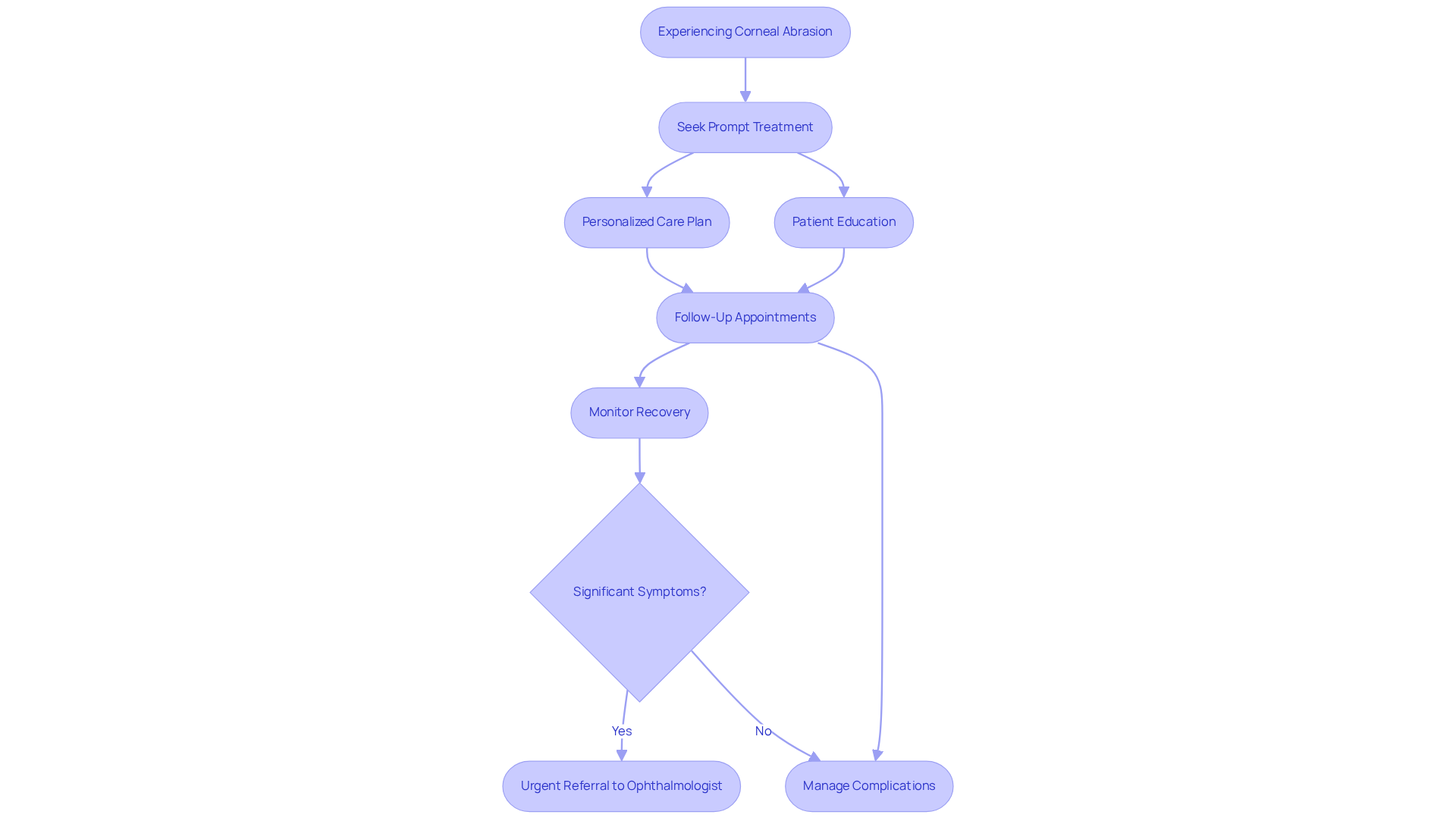
Understand the Healing Process of Corneal Abrasions
Corneal injuries can be concerning, but it’s important to know that they heal remarkably quickly. In fact, studies show that about 90% of small eye surface injuries recover within just 24 to 48 hours. This rapid healing happens because the epithelial cells multiply swiftly to repair the eye surface. Most injuries heal within three days, which is crucial for setting your expectations.
However, if you experience deeper abrasions, healing might take a bit longer-sometimes up to a week or more, depending on how severe the injury is. We understand that this can be worrying, and that’s why ophthalmologists emphasize the importance of understanding the healing process. Knowing what to expect can help you stick to your treatment plan and manage your expectations effectively.
For instance, one specialist points out that the eye surface’s ability to regenerate is vital for preserving your vision and avoiding complications. It’s common to feel anxious during recovery, but there are pain control alternatives, like oral analgesics, that can help ease discomfort.
This knowledge can empower you to stay calm and compliant during your recovery. Just remember, if the injury doesn’t heal fully, there’s a chance of complications like recurrent eye erosion. We are here to help you through this process, ensuring you have the support you need every step of the way.
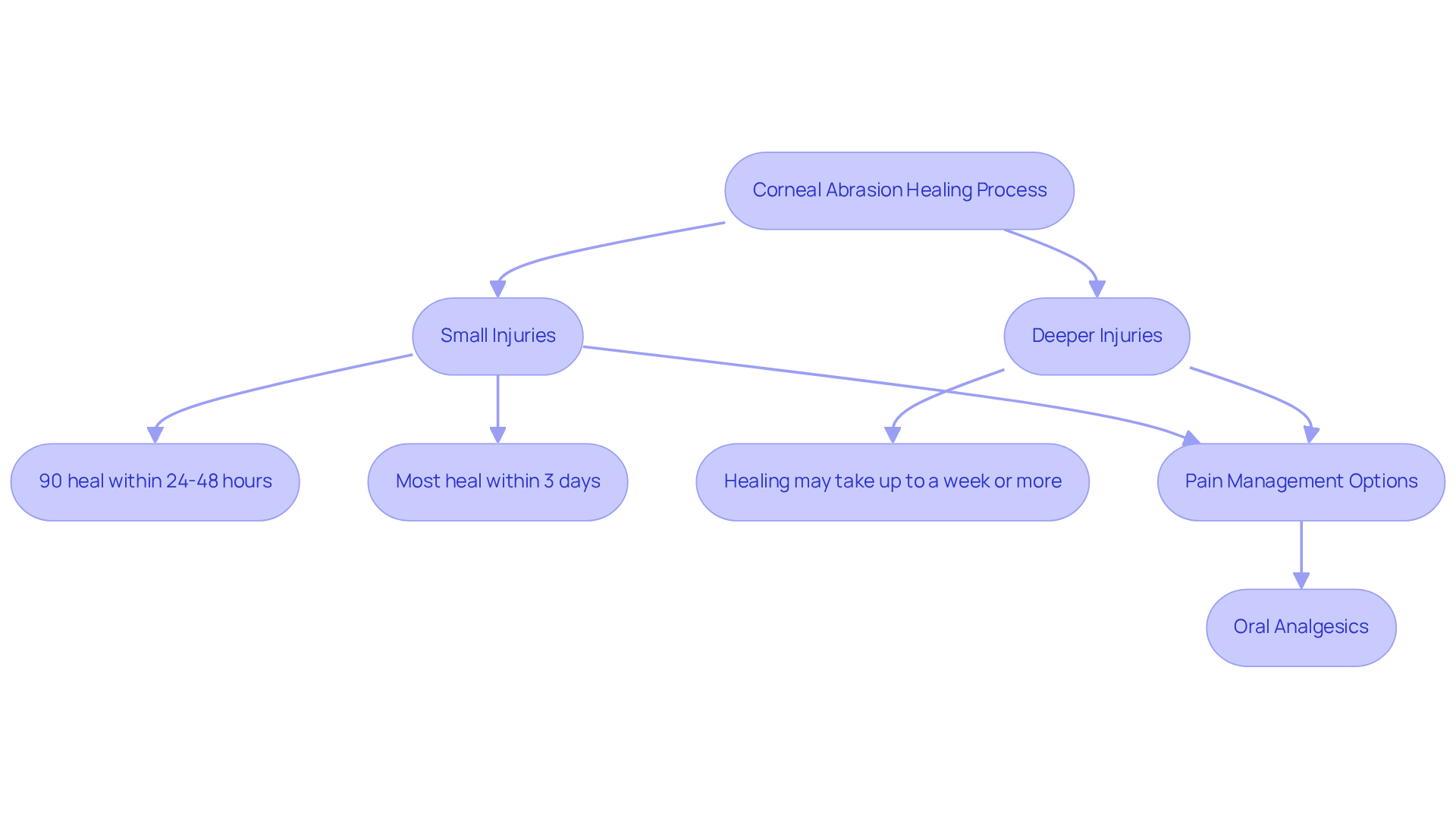
Recognize Symptoms of Corneal Abrasion for Timely Treatment
If you’ve ever experienced an eye scratch, you know how distressing it can be. Common symptoms include:
- Sharp pain
- A gritty feeling in the eye
- Tearing
- Redness
- Increased sensitivity to light
It’s also not unusual to feel like something is stuck in your eye or to have blurred vision. We understand that identifying these symptoms early is crucial for taking prompt action. Research shows that the corneal abrasion healing time for most corneal injuries is only a few days, which is reassuring.
While minor scrapes often heal on their own, it’s wise to consider treatment with antibiotic drops or ointment to reduce the risk of infection. Eye care specialists, like Dr. Chow, emphasize the importance of prompt intervention. Even slight injuries can lead to significant discomfort due to the cornea’s high concentration of nerve fibers. Moreover, untreated injuries can result in long-term vision issues, which is why seeking medical care is so important.
To aid in your recovery, we recommend using an eyecup or a clean drinking glass to rinse your eye effectively. Staying vigilant about these symptoms and being proactive in seeking care can make a big difference. Remember, your Northwest Eye physician is here to suggest the best approach to address your eye injury. We are here to help you through this process.
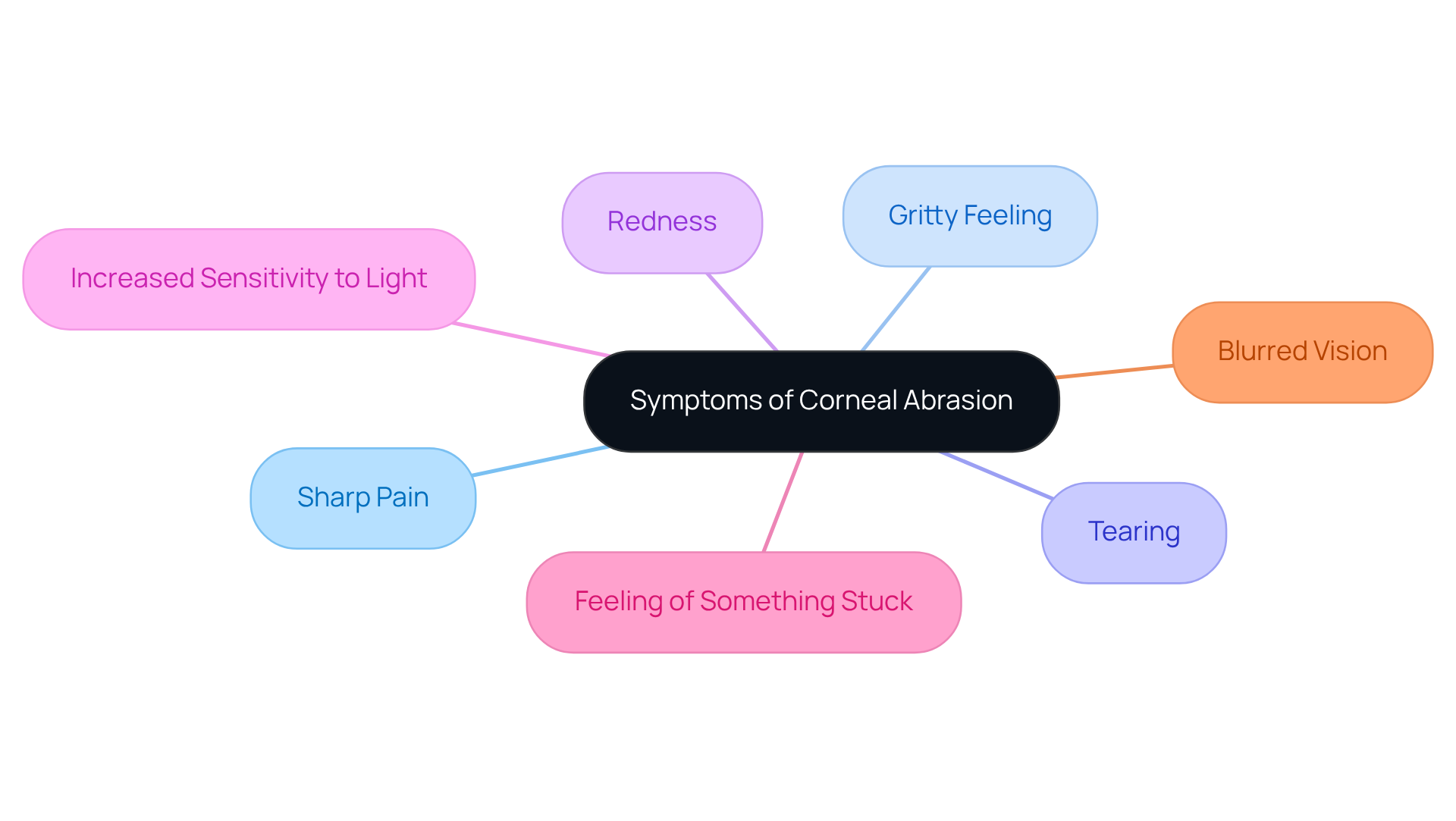
Explore Treatment Options for Corneal Abrasions
When it comes to treating corneal injuries, our main focus is on easing your pain and preventing any infections. The cornea is essential for your eye health, as it helps focus light onto the lens and filters out harmful UV rays. We understand that dealing with an eye injury can be concerning, but antibiotic eye drops play a crucial role in your recovery, significantly lowering the risk of infection and promoting healing.
For minor scrapes, you’ll be relieved to know that the corneal abrasion healing time typically ranges from just 1-2 days. During this time, lubricating eye drops can provide much-needed comfort. In some cases, a bandage contact lens may be used to protect your cornea throughout the corneal abrasion healing time. If your injury is more serious, oral pain relievers, including narcotics, might be necessary to help manage your discomfort effectively.
Every treatment plan is tailored to the severity of your injury and your overall health, ensuring the best possible healing outcomes. Recent advancements, like topical nonsteroidal anti-inflammatory drops, have shown great promise in enhancing recovery and minimizing pain. Specialists often recommend a combination of treatments, including antibiotics and lubricating substances, as the most effective way to handle eye scratches and support your recovery.
It’s important to remember that untreated severe wounds can lead to scarring or eye opacity, which is why prompt and efficient care is so vital. We are here to help you through this process, ensuring you receive the care and support you need.
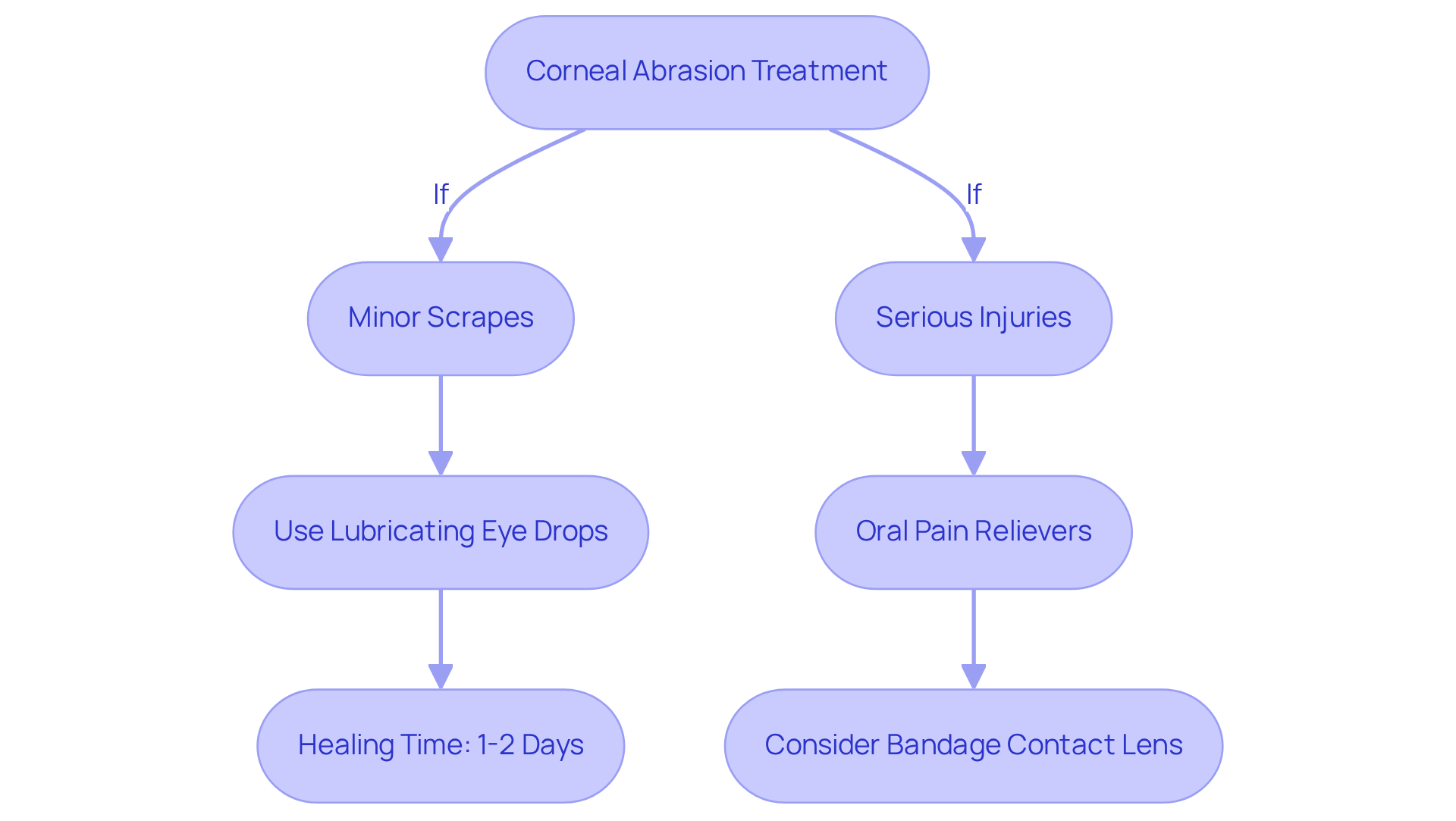
Implement Preventive Strategies Against Corneal Abrasions
We understand that avoiding eye injuries is a significant concern for many. It requires a comprehensive strategy that emphasizes the importance of protective eyewear during high-risk activities, like sports, home improvement tasks, and any work involving machinery. Research shows that using suitable protective eyewear can greatly decrease the occurrence of eye injuries, which happen in just 0.03-0.17 percent of instances. This statistic highlights the necessity of taking preventive measures seriously.
It’s also essential to maintain good hygiene practices. Washing your hands before touching your face and keeping your fingernails trimmed can minimize the risk of accidental scratches. The American Academy of Family Physicians advises cutting fingernails to avoid scratching the eye, reinforcing how crucial this practice is.
Educating children about eye safety is particularly important, as they are often more susceptible to injuries. Parents should ensure that children wear protective eyewear during play and teach them the importance of avoiding eye contact with sharp objects. Frequent reasons for eye scratches include:
- Fingernails
- Contact lenses
- Foreign objects
Making awareness of these dangers essential.
By applying these strategies, you can significantly lower your risk of suffering eye injuries and safeguard your sight. Remember, we are here to help you through this process.
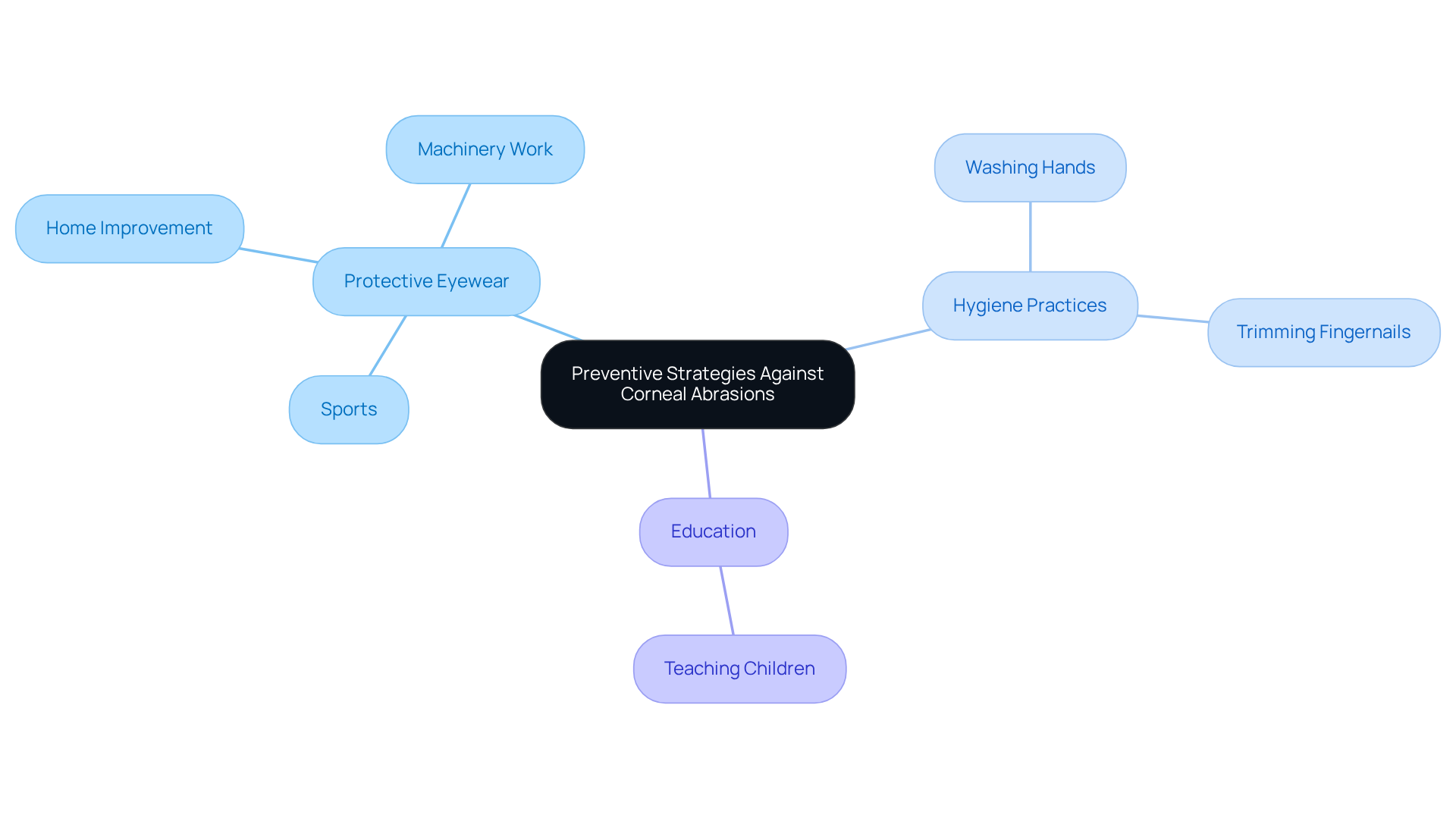
Utilize Home Care Tips for Corneal Abrasion Recovery
To promote corneal abrasion healing time, it’s important to prioritize several key practices. We understand that the discomfort can be overwhelming, and avoiding the urge to rub your eyes is crucial. Rubbing can exacerbate discomfort and delay healing. Using lubricating eye drops is strongly advised; research shows that these drops greatly help in preserving moisture and comfort during your recovery. Many patients have shared that regular use of lubricating drops effectively alleviates their symptoms.
Additionally, applying a cool compress can provide immediate relief from discomfort. Following any prescribed medication regimen, including antibiotic drops, eye patching, or steroid eye drops, is essential to prevent infection and ensure optimal corneal abrasion healing time. It’s vital to refrain from wearing contact lenses until you’re cleared by an eye care provider, as improper use can lead to further complications.
Understanding the symptoms of corneal abrasions – such as intense eye pain, excessive tearing, eye redness, sensitivity to light, and blurred vision – can aid in recognizing the condition early. By following these best practices and being informed about the causes and treatment options available at Northwest Eye, you can improve your healing experience and promote optimal restoration. Remember, we are here to help you through this process.
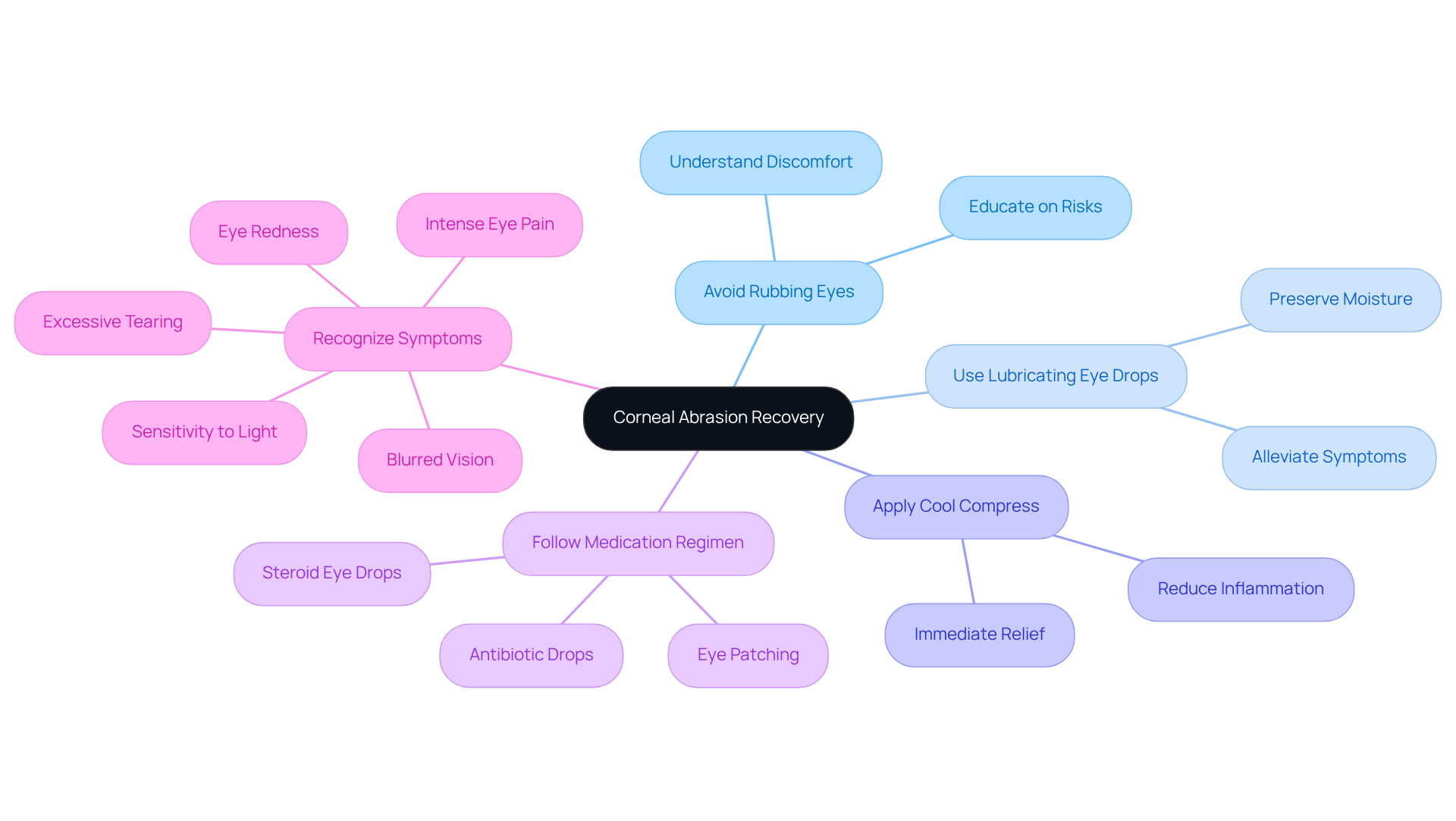
Know When to Consult a Doctor for Corneal Abrasions
If you’re experiencing severe pain, persistent symptoms lasting beyond a few days, or any changes in your vision, it’s important to seek medical attention. We understand that these signs can be concerning. Look out for:
- Increased redness
- Swelling
- Discharge
- Worsening pain
These could indicate an infection or a deeper injury. Early intervention is crucial; studies show that timely medical attention can significantly improve corneal abrasion healing time, thereby reducing the risk of long-term complications like scarring or vision loss.
Eye care professionals emphasize the importance of recognizing these symptoms early. Doing so can lead to better recovery outcomes and help prevent serious issues. For instance, blurred vision might signal various eye problems, including:
- Surface scratches on the cornea
- Cataracts
- Diabetic retinopathy
If left untreated, eye surface scratches can develop into ulcers, posing a significant risk to your vision.
Therefore, it’s essential to monitor symptoms such as pus discharge and persistent pain closely. Consulting a doctor promptly can help optimize the corneal abrasion healing time. Remember, follow-up care is vital to assess healing and address any arising issues. Only a Northwest Eye doctor or eye care professional can provide an accurate diagnosis and appropriate treatment options. We are here to help you through this process.

Differentiate Corneal Abrasions from Other Eye Conditions
Eye scratches can often be mistaken for other eye issues, like conjunctivitis and eye ulcers. We understand that it can be confusing when your eyes are bothering you. While conjunctivitis usually presents with redness and discharge, eye scratches are marked by sharp pain and a gritty sensation. On the other hand, eye ulcers tend to show more severe symptoms, such as intense redness, swelling, and even the risk of vision loss. Misdiagnosis can lead to inappropriate treatment, which is why recognizing these differences is so important.
Studies indicate that eye scratches are among the most common ocular injuries. However, they might be overlooked in favor of diagnosing conjunctivitis, which is often caused by infections or allergies. It’s common to feel overwhelmed by these symptoms, but understanding these distinctions is vital for getting the right treatment and preventing complications.
If you’re experiencing discomfort, remember that you’re not alone. Many people have faced similar situations, and it’s crucial to seek the right care. We are here to help you through this process and ensure you receive the support you need.
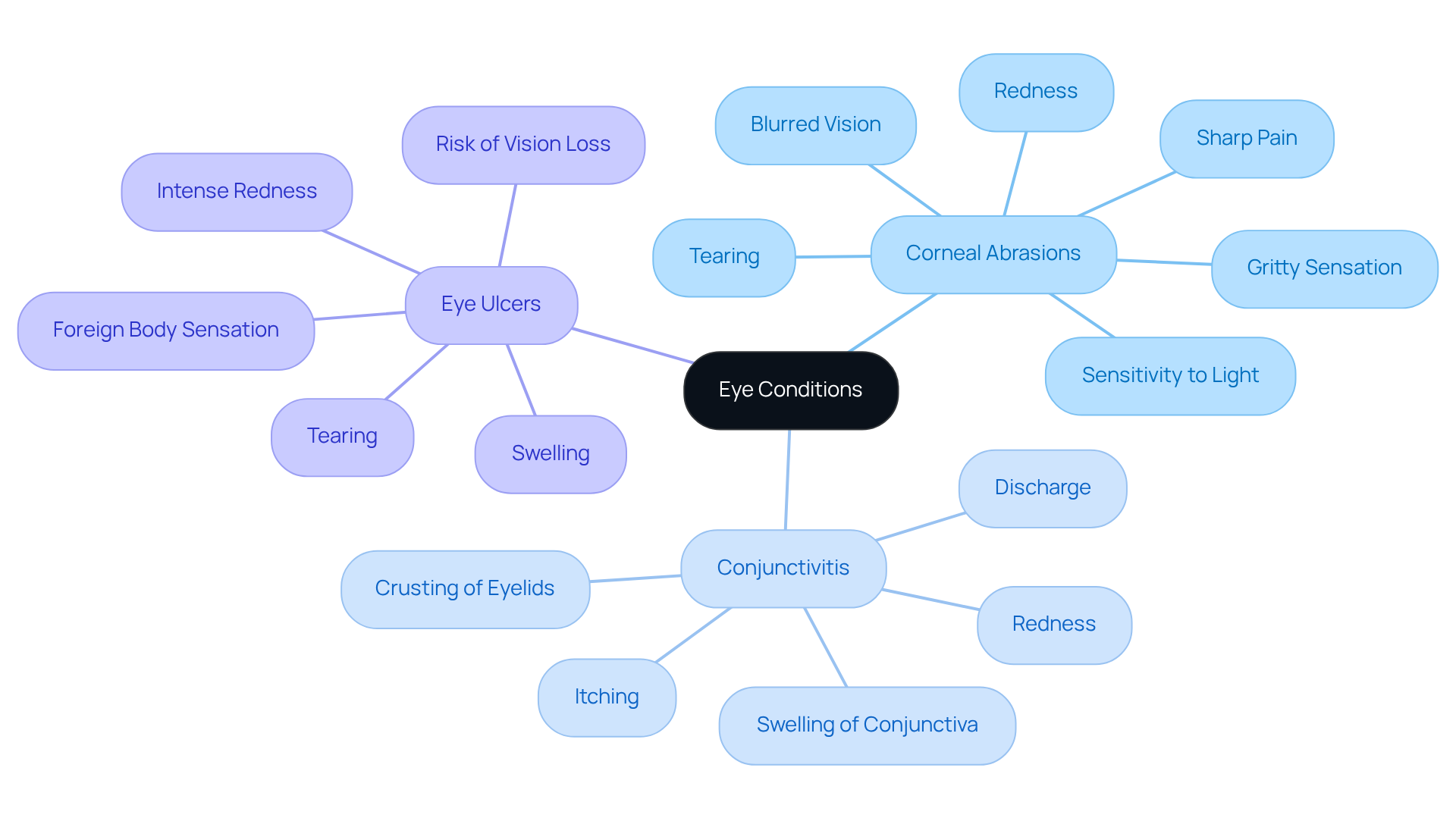
Understand the Recovery Timeline for Corneal Abrasions
We understand that dealing with eye surface scratches can be concerning. The duration of healing, known as corneal abrasion healing time, varies based on the severity of the injury. Minor scratches typically heal within 1 to 3 days, and the corneal abrasion healing time often allows most patients to notice significant improvement in symptoms, including a considerable decrease in pain, within the first 48 hours. As Grace Zhang, MD, points out, the corneal abrasion healing time is usually 1-3 days.
It’s common to feel anxious about deeper wounds, as their corneal abrasion healing time may require up to a week or longer for full recovery. While minor abrasions resolve quickly, deeper injuries can lead to prolonged discomfort and may necessitate more intensive care. We want you to know that it’s essential to watch for possible complications, such as infection, which can result in eye ulcers if left untreated.
Routine follow-up visits with an eye care professional are crucial to ensure proper healing and address any concerns that may arise during the process. Remember, we are here to help you through this journey.
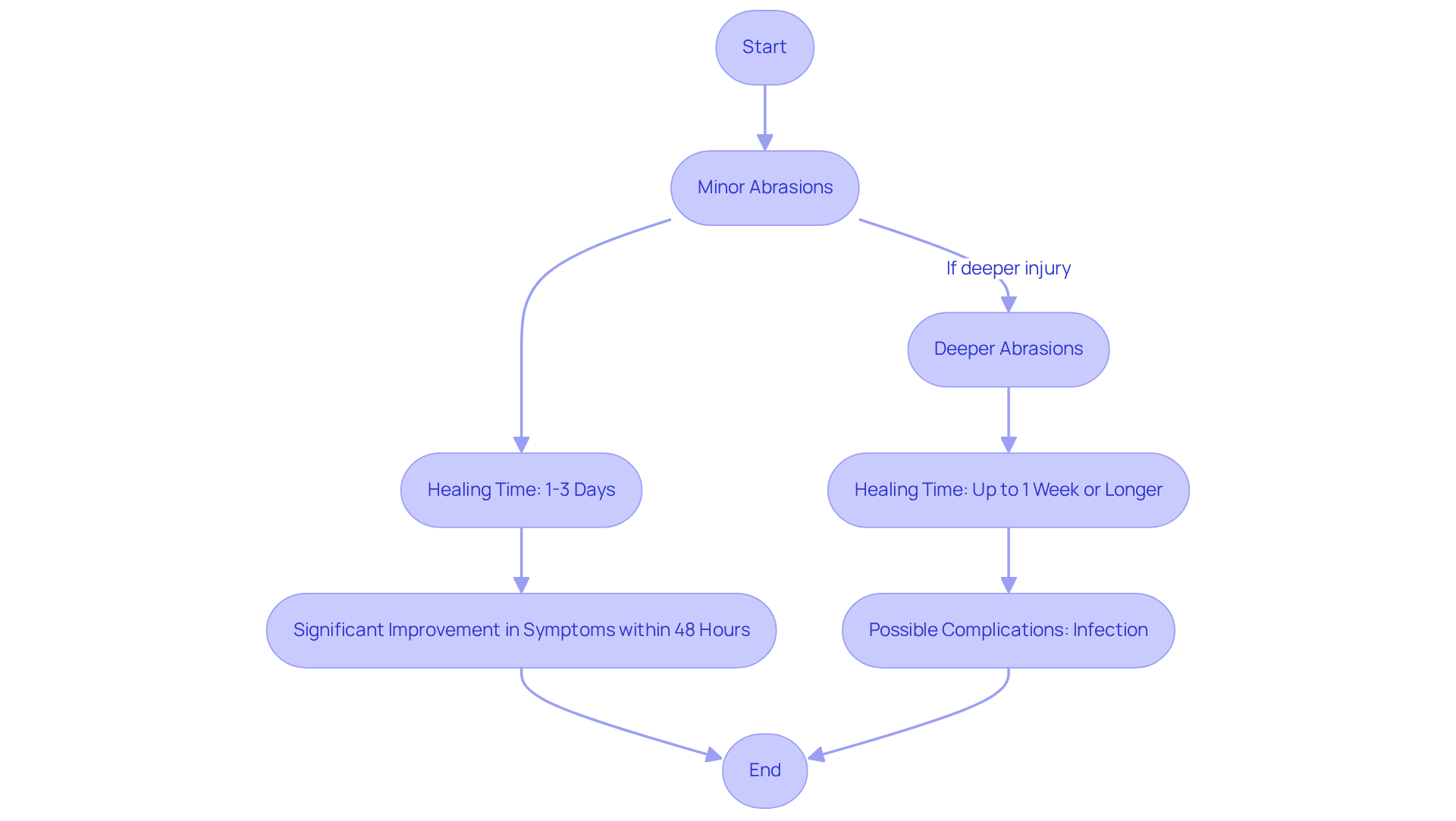
Prioritize Follow-Up Care After Corneal Abrasion Treatment
After treatment for a corneal injury, we understand that prioritizing follow-up care is essential for your corneal abrasion healing time. These appointments are crucial as they allow your eye care provider to assess your healing process, make necessary adjustments to your treatment, and address any concerns that may arise. Research shows that the corneal abrasion healing time for most small injuries is within 1 to 3 days, and patients who actively participate in follow-up care often experience significantly better recovery outcomes.
Ophthalmologists emphasize that timely follow-ups can help prevent complications such as infections or prolonged discomfort. As Dr. Patricia Pinto-Garcia, MD, MPH, wisely states, “Following up with your doctor after treatment can help avoid complications.” During these visits, you can expect a thorough examination of your cornea, an assessment of your symptoms, and discussions about any changes in your vision or discomfort.
It’s common to feel anxious about your recovery, but if a scratch on your eye does not improve after 24 hours, we recommend consulting an optometrist or ophthalmologist to understand the corneal abrasion healing time. If your symptoms worsen or do not improve, seeking immediate consultation with an eye care professional is crucial to ensure proper healing and avoid long-term complications. Remember, corneal abrasions account for approximately 8% of serious eye injuries that prompt individuals to seek medical attention. We are here to help you through this process.
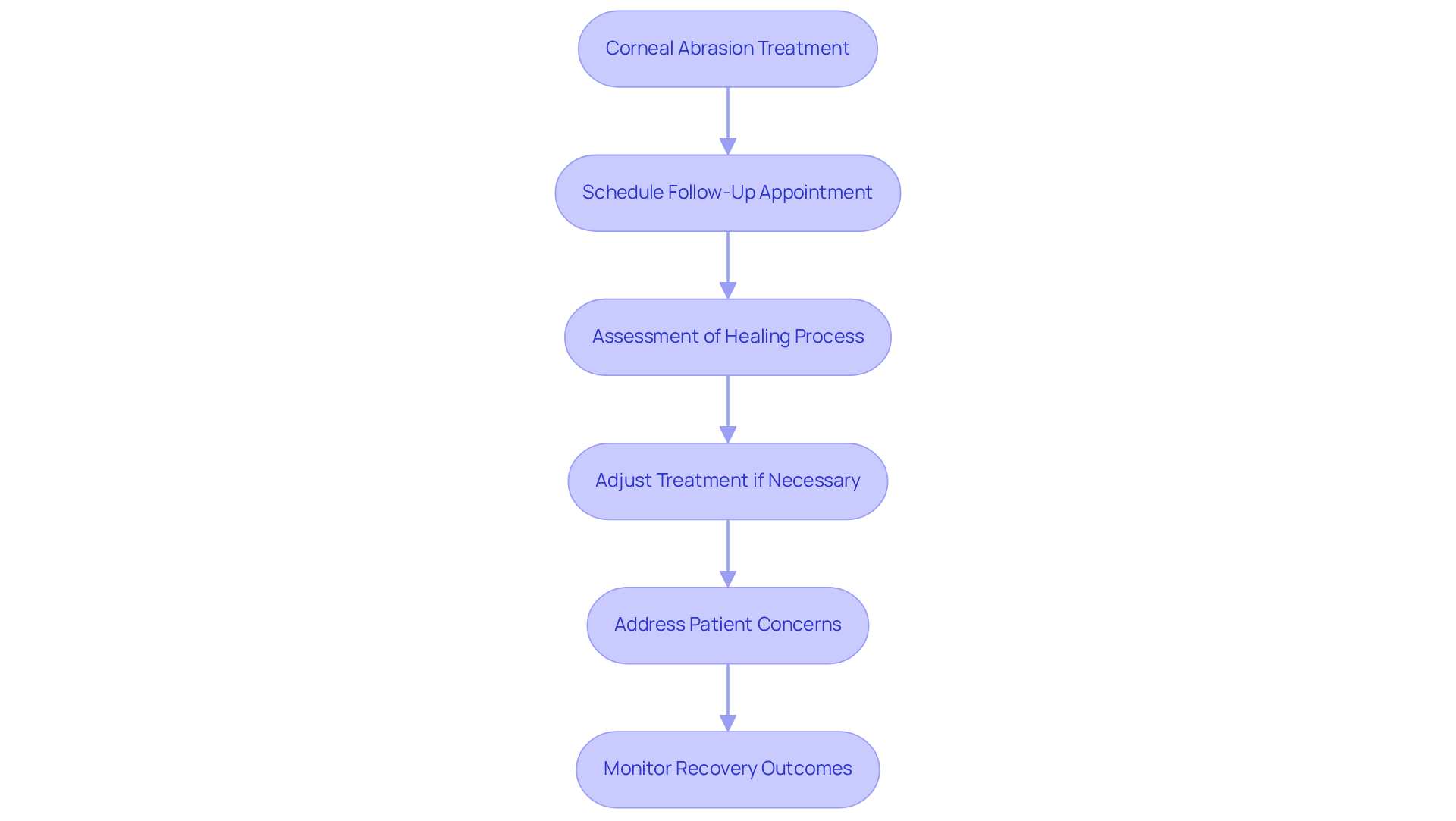
Conclusion
Understanding corneal abrasions and their healing process is essential for anyone dealing with eye injuries. We understand that facing an eye injury can be concerning, but the good news is that most corneal abrasions heal quickly, typically within 1 to 3 days. Seeking timely treatment is crucial to prevent complications and ensure a smooth recovery.
Recognizing symptoms early is key. It’s common to feel discomfort or irritation, and knowing what to expect can significantly enhance your healing experience. There are various treatment options available, and implementing preventive strategies can help you avoid future injuries. Remember, follow-up care is just as important. Monitoring your recovery allows for addressing any potential issues, reinforcing that proactive measures can lead to better outcomes.
Ultimately, safeguarding your eye health requires awareness and action. By prioritizing timely medical attention, adhering to recommended care practices, and educating yourself about the signs and symptoms of corneal abrasions, you can play an active role in your recovery. We are here to help you through this process. Taking these steps not only aids in healing but also helps preserve your long-term vision health.
Frequently Asked Questions
What is a corneal abrasion and why is it concerning?
A corneal abrasion is a scratch on the surface of the eye, which can be concerning due to the potential for pain and complications if not treated properly.
How quickly do corneal abrasions heal?
Most small corneal abrasions heal within 1 to 3 days, with about 90% recovering within 24 to 48 hours.
What factors can affect the healing time of a corneal abrasion?
Healing time can vary based on the severity of the abrasion; deeper injuries may take a week or more to heal.
What are the common symptoms of a corneal abrasion?
Common symptoms include sharp pain, a gritty feeling in the eye, tearing, redness, increased sensitivity to light, the sensation of something stuck in the eye, and blurred vision.
Why is it important to seek treatment for a corneal abrasion?
Prompt treatment is crucial to reduce the risk of infection and prevent long-term vision issues, as untreated injuries can lead to significant discomfort and complications.
What treatments are available for corneal abrasions?
Treatments may include antibiotic drops or ointment to prevent infection, as well as pain control alternatives like oral analgesics.
What should I do if I suspect I have a corneal abrasion?
If you experience symptoms of a corneal abrasion, it’s important to seek medical care from an ophthalmologist for proper evaluation and treatment.
How can I aid in the recovery of a corneal abrasion?
You can rinse your eye using an eyecup or a clean drinking glass to help with recovery, but it’s essential to follow the guidance of your eye care physician.
What happens if a corneal abrasion does not heal properly?
If a corneal abrasion does not heal fully, there is a risk of complications such as recurrent eye erosion, which can affect vision.
What is the success rate of eye injury treatments at Northwest Eye?
Northwest Eye has a remarkable success rate of 93% for eye injury treatments, indicating a high level of patient satisfaction and effective care.



